Jesus is Alive! (Part 2)
Jesus is alive! This affirmation is based on the accounts of the Gospels and the Book of Acts. But what do they actually say, and can they be coherently read as one singular account?
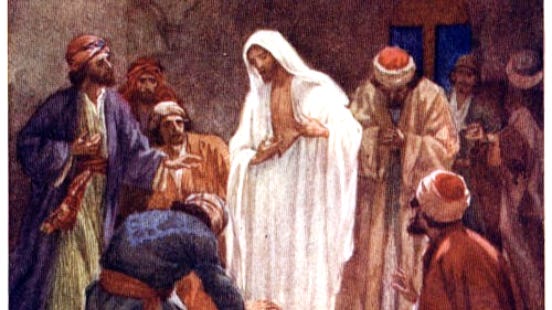
Setting the Stage
In the previous installment of this series, we highlighted how Christians claim Jesus of Nazareth literally, physically, bodily, and totally rose from the dead three days after He was executed. The significance of this claim is quite literally of infinite proportion, because if Jesus rose from the dead, then it means at least one person has not only died (like all of us will), but He came back to tell us what happens next and how to get there. If you haven’t read the previous installment, I highly recommend you stop what you are doing and go do so now (you can find the link here). If you are ready, we will begin examining what happened on Resurrection morning according to the written accounts of the Gospels and the beginning of the Book of Acts.
The Gospels are four written accounts of Jesus’ life, ministry, death, and Resurrection, all written between A.D. 33 and circa A.D. 62.[1] The Gospel of Matthew was written by Matthew, a Jewish follower of Jesus who was formerly a tax collector.[2] The Gospel of Mark was written by a man named John Mark who was a companion of the Apostle Paul and a follower of the Apostle Peter (and potentially a follower of Jesus as a young man).[3] The Gospel of Luke was written by a Greek physician named Luke who was a travelling companion of the Apostle Paul.[4] The Gospel of John was written by the Apostle John, another Jewish follower of Jesus who records many more private conversations, teachings, and miracles which the other three Gospels do not record.[5] The Book of Acts was written after Luke wrote the Gospel bearing his name, and is a historical record of the Church from the Resurrection and Ascension of Jesus until Paul’s first imprisonment in the city of Rome.[6]
You may be wondering, “why are we going to read these? Aren’t they biased?” There are three reasons we are reading these accounts: first, these are the only records about Jesus written by eyewitnesses who interacted with Him on a daily basis during His lifetime, second, Christians base their belief in Jesus’ Resurrection on these accounts, so if you want to respond to what Christians believe you must engage what these accounts are actually claiming, and third, these accounts are historically reliable documents. We will defer our primary examination of the reliability of these documents for our next installment of this series (although you may find some helpful information and responses to critics in the endnotes of this article).
What follows is perhaps a somewhat unique presentation of the accounts of Jesus’ Resurrection. What you will be reading is a synthesis of these accounts. I have taken a version of the Bible which is both readable and faithful to the original Greek (the English Standard Version), and combined the accounts of all four Gospels and the beginning of the Book of Acts and, like a puzzle, I have put the pieces as best I can into one coherent account. With the exception of two sentences, I have not changed any of the wording provided by the ESV, and I have noted where these changes are. You are not only welcome, but encouraged to find a copy of the ESV and check my work. I am confident you will find there are no contradictions in the accounts, and that they all record one coherent event affirming the same fundamental truths: Jesus Christ died, rose from the dead, and was seen, heard, and touched by various people in various times and various places immediately after His Resurrection. Are you ready to “come and see?”[7]
The Events of Resurrection Morning and Afterward in Order of Occurrence
A Synthesized Account of All Four Gospels and the Ascension Account of the Book of Acts
When the Sabbath[8] was past[9], toward the dawn of the first day of the week[10], Mary Magdalene, Mary the mother of James, and Salome bought spices, so that they could anoint him[11].
[[And] Joanna and the other women went with them to the tomb, taking the spices they had prepared.][12] And they were saying to one another, "Who will roll away the stone for us from the entrance of the tomb?"[13]
And behold, there was a great earthquake, for an angel of the Lord descended from heaven and came and rolled back the stone and sat on it. His appearance was like lightning, and his clothing white as snow. And for fear of him the guards trembled and became like dead men.[14] And looking up,[15] the women saw that the stone had been rolled back - it was very large.[16] And entering the tomb, they did not find the body of the Lord Jesus. While they were perplexed about this, behold, they saw two men stood by them in dazzling apparel.[17] [[One of them sat] on the right side, dressed in a white robe, and they were alarmed.][18]
And as they were frightened and bowed their faces to the ground, the man said to them,[19] "Do not be alarmed,[20] for I know that you seek Jesus who was crucified.[21] Why do you seek the living among the dead?[22] He is not here, for he has risen as he said.[23] Remember how he told you, while he was still in Galilee, that the Son of Man must be delivered into the hands of sinful men and be crucified and on the third day rise.[24] Come, see the place where he lay.[25] Then go quickly and[26] tell his disciples and Peter,[27]he has risen from the dead and that he is going before you to Galilee.[28] There you will see him just as he told you.[29] See, I have told you."[30]
And they remembered his words,[31] and they went out and fled from the tomb, for trembling and astonishment and great joy had seized them, and they said nothing to anyone, for they were afraid.[32]
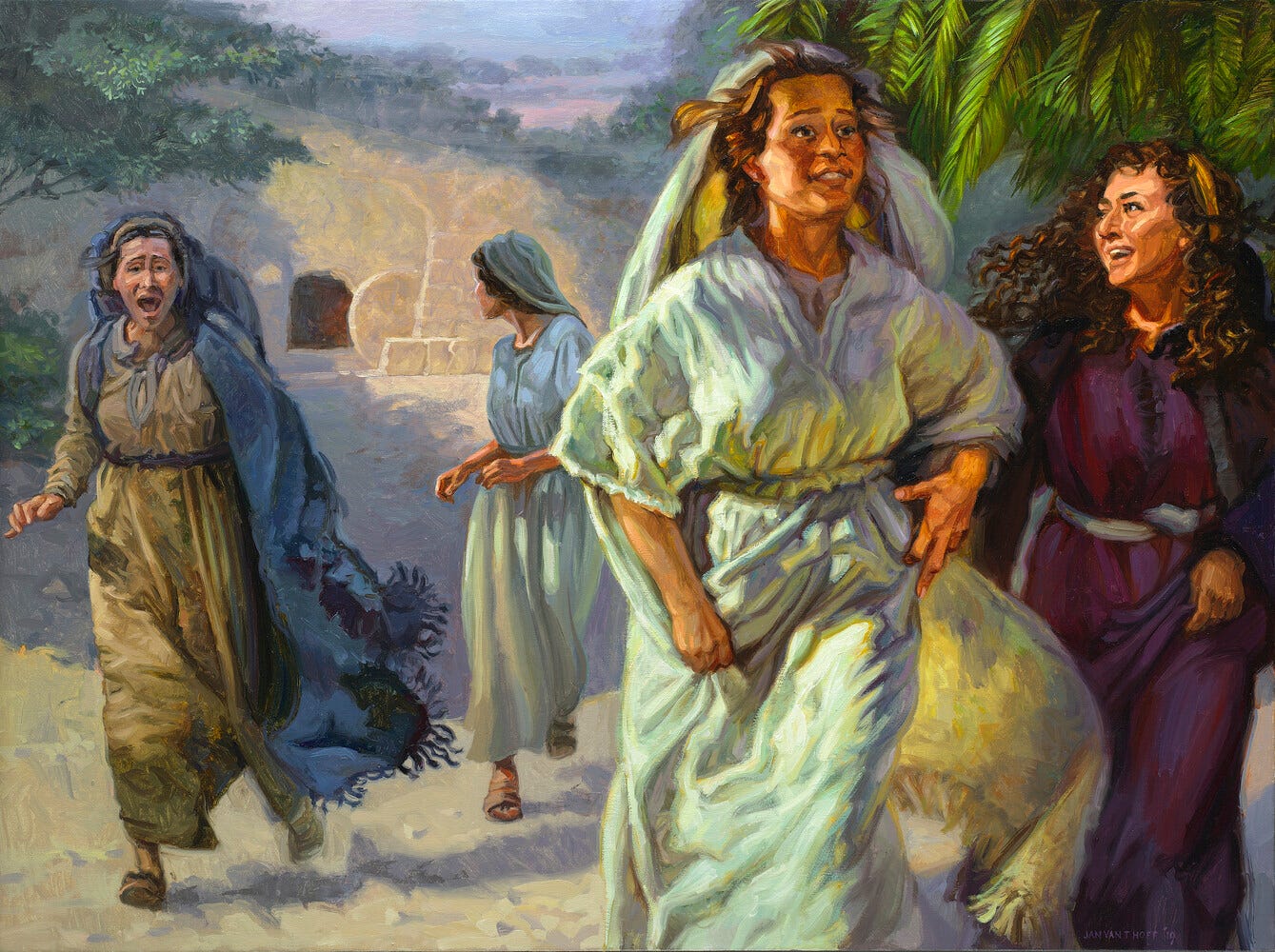
And while they were going, behold, some of the guard went into the city and told the chief priests all that had taken place. And when they had assembled with the elders and taken counsel, they gave a sufficient sum of money to the soldiers and said, "Tell people, 'His disciples came by night and stole him away while we were asleep.' And if this comes to the governor's ears, we will satisfy him and keep you out of trouble." So they took the money and did as they were directed. And this story has been spread among the Jews to this day.[33]
[Now Mary Magdalene] ran to Simon Peter and the other disciple, the one whom Jesus loved, and said to them, "They have taken the Lord out of the tomb, and we do not know where they have laid him." So Peter went out with the other disciple, and they were going toward the tomb. Both of them were running together, but the other disciple outran Peter and reached the tomb first. And stooping to look in, he saw the linen cloths lying there, but he did not go in. Then Simon Peter came, following him, and went into the tomb. He saw the linen cloths lying there, and the face cloth, which had been on Jesus' head, not lying with the linen cloths but folded up in a place by itself. Then the other disciple, who had reached the tomb first, also went in, and he saw and believed; for as yet they did not understand the Scripture, that he must rise from the dead. Then the disciples went back to their homes.[34]
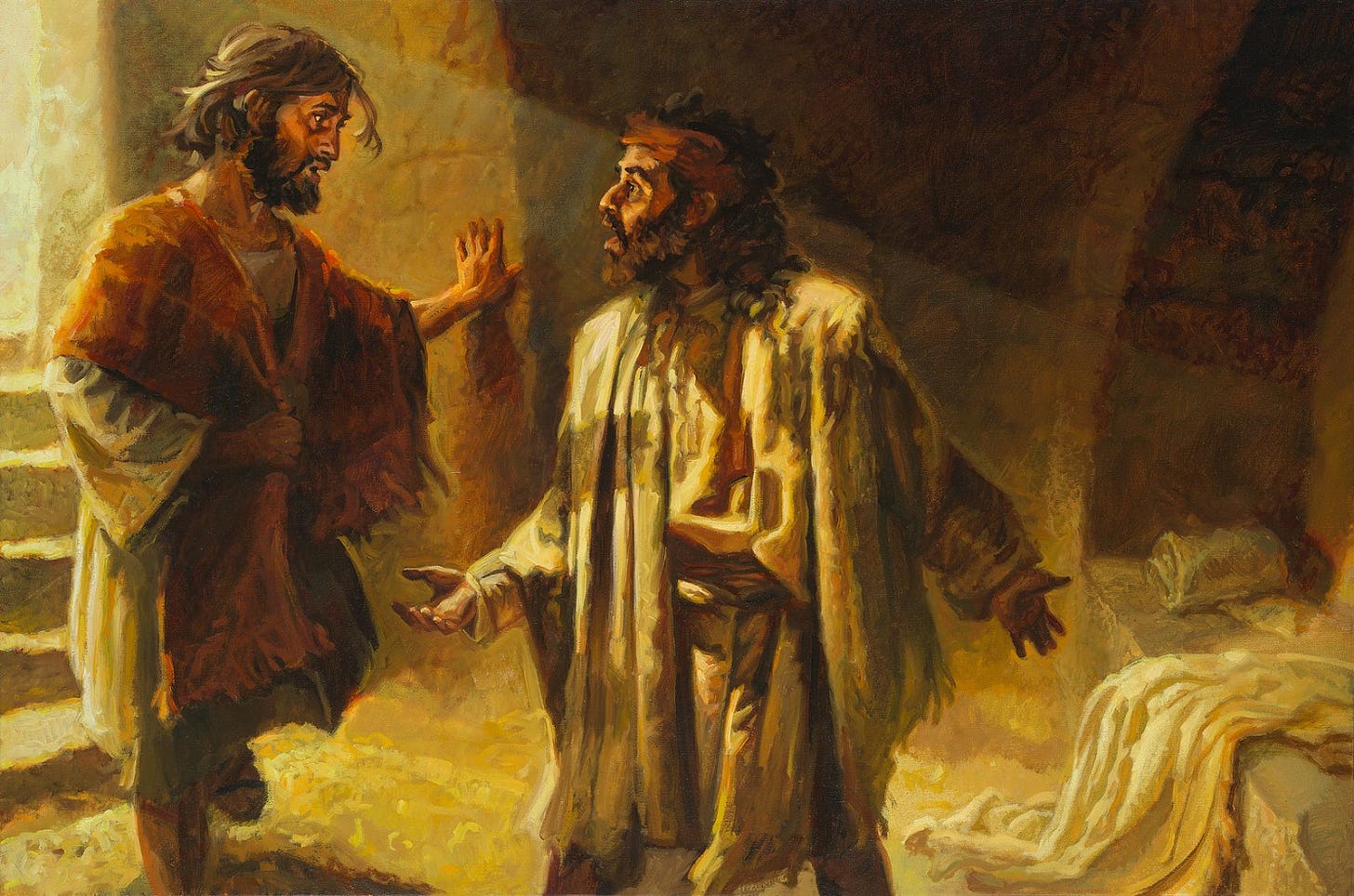
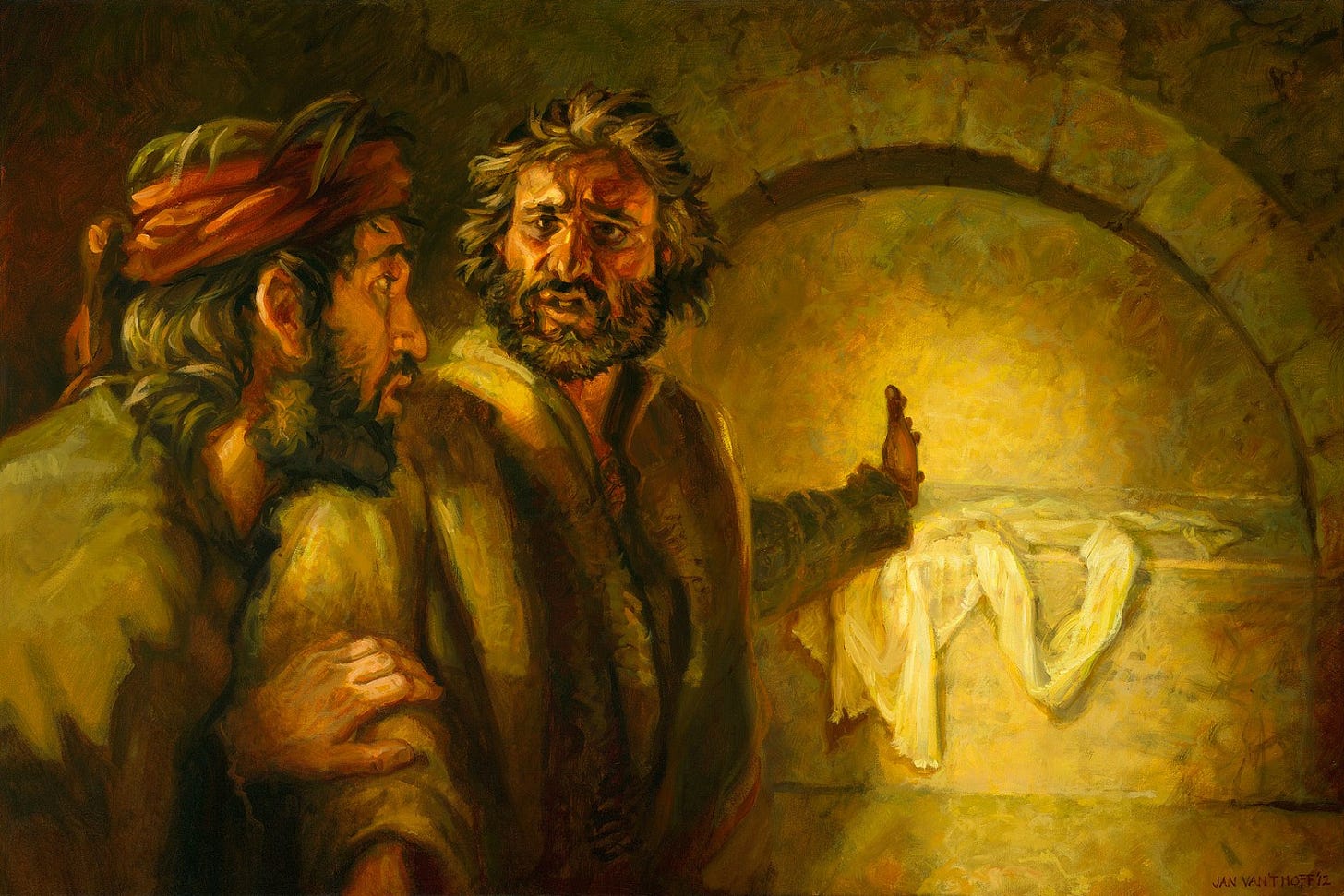
But Mary stood weeping outside the tomb, and as she wept she stooped to look into the tomb. And she saw two angels in white, sitting where the body of Jesus had lain, one at the head and one at the feet. They said to her, "Woman, why are you weeping?"[35]
She said to them, "They have taken away my Lord, and I do not know where they have laid him."[36]
Having said this, she turned around and saw Jesus standing, but she did not know that it was Jesus.[37]
Jesus said to her, "Woman, why are you weeping? Whom are you seeking?" Supposing him to be the gardener, she said to him, "Sir, if you have carried him away, tell me where you have laid him, and I will take him away." Jesus said to her, "Mary." She turned and said to him in Aramaic, "Rabboni!" (which means Teacher). Jesus said to her, do not cling to me, for I have not yet ascended to the father; but go to my brothers and say to them, 'I am ascending to my Father and your Father, to my God and your God.'" Mary Magdalene went and announced to the disciples, "I have seen the Lord" - and that he had said these things to her.[38]
And behold, Jesus met the women while they were going and said, "Greetings!"[39]
And they came up and took hold of his feet and worshiped him. Then Jesus said to them, "Do not be afraid; go and tell my brothers to go to Galilee, and there they will see me."[40] And they told all these things to the eleven and to all the rest. Now it was Mary Magdalene and Joanna and Mary the mother of James and the other women with them who told these things to the apostles, but these words seemed to them an idle tale, and they did not believe them. But Peter rose and ran to the tomb; stooping and looking in, he saw the linen cloths by themselves; and he went home marveling at what had happened.[41]
That very day two of them were going to a village named Emmaus, about seven miles from Jerusalem, and they were talking with each other about all these things that had happened. While they were talking and discussing together, Jesus himself drew near and went with them. But their eyes were kept from recognizing him. And he said to them, "What is this conversation that you are holding with each other as you walk?" And they stood still, looking sad. Then one of them, named Cleopas, answered him, "Are you the only visitor to Jerusalem who does not know the things that have happened there in these days?" And he said to them, "What things?" And they said to him, "Concerning Jesus of Nazareth, a man who was a prophet mighty in deed and word before God and all the people, and how our chief priests and rulers delivered him up to be condemned to death, and crucified him. But we had hoped that he was the one to redeem Israel. Yes, and besides all this, it is now the third day since these things happened. Moreover, some women of our company amazed us. They were at the tomb early in the morning, and when they did not find his body, they came back saying that they had even seen a vision of angels who said that he was alive. Some of those who were with us went to the tomb and found it just as the women had said, but him they did not see." And he said to them, "O foolish ones, and slow of heart to believe all that the prophets have spoken! Was it not necessary that the Christ should suffer these things and enter into his glory?" And beginning with Moses and all the Prophets, he interpreted to them in all the Scriptures the things concerning himself.
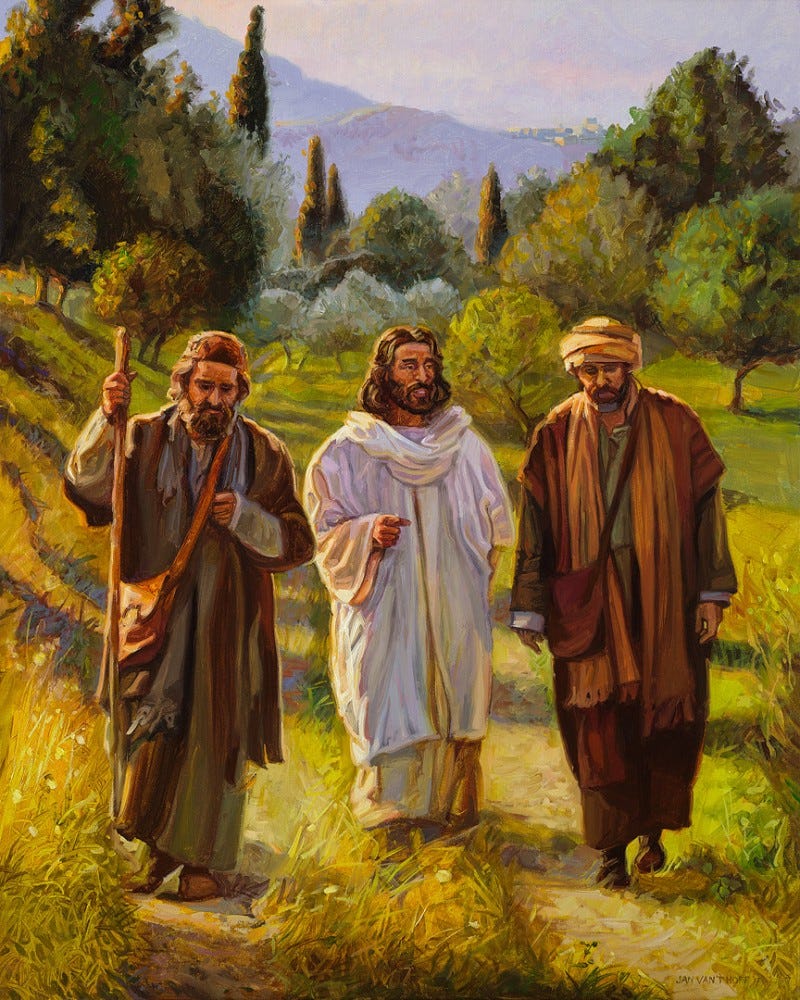
So they drew near to the village to which they were going. He acted as if he were going farther, but they urged him strongly, saying, "Stay with us, for it is toward evening and the day is now spent." So he went in to stay with them. While he was at the table with them, he took the bread and blessed and broke it and gave it to them. And their eyes were opened, and they recognized him. And he vanished from their sight. They said to each other, "Did not our hearts burn within us while he talked to us on the road, while he opened to us the Scriptures?" And they rose that same hour and returned to Jerusalem. And they found the eleven and those who were with them gathered together, saying, "The Lord has risen indeed, and has appeared to Simon!" Then they told what had happened on the road and how he was known to them in the breaking of the bread.[42]
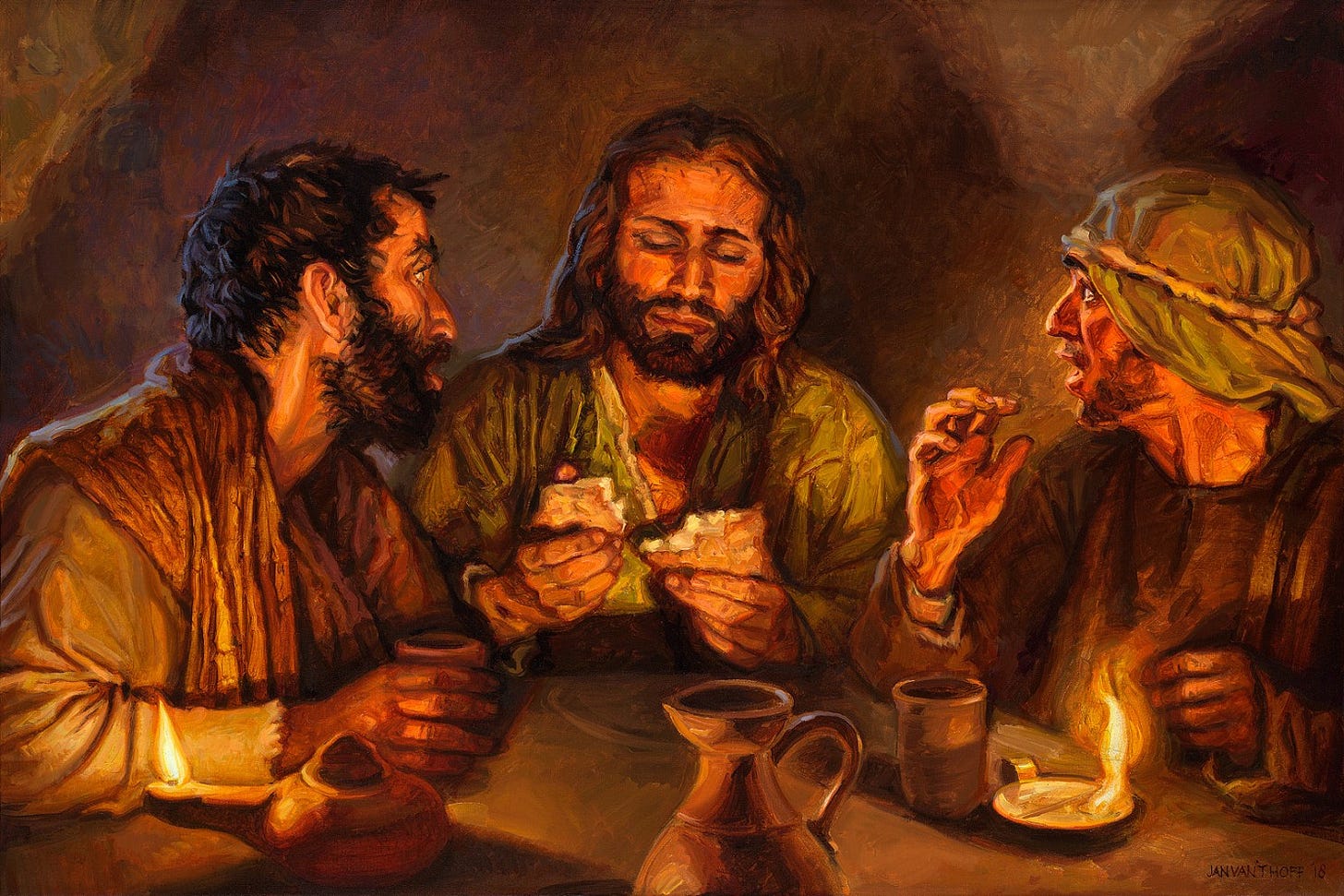
As they were talking about these things,[43] [o]n the evening of that day, the doors being locked where the disciples were for fear of the Jews,[44] Jesus came and stood among them and said to them, "Peace be with you!"[45] But they were startled and frightened and thought they saw a spirit. And he said to them, "Why are you troubled, and why do doubts arise in your hearts? See my hands and my feet, that it is I myself. Touch me, and see. For a spirit does not have flesh and bones as you see that I have." And when he had said this, he showed them his hands and his feet[46] and his side.[47] Then the disciples were glad when they saw the Lord.[48] And while they still disbelieved for joy and were marveling, he said to them, "Have you anything here to eat?" They gave him a piece of broiled fish, and he took it and ate before them.[49] Jesus said to them again, "Peace be with you. As the Father has sent me, even so I am sending you." And when he had said this, he breathed on them and said to them, "Receive the Holy Spirit. If you forgive the sins of any, they are forgiven them; if you withhold forgiveness from any, it is withheld."[50] Then he said to them, "These are my words that I spoke to you while I was still with you, that everything written about me in the Law of Moses and the Prophets and the Psalms must be fulfilled." Then he opened their minds to understand the Scriptures, and said to them, "Thus it is written, that the Christ should suffer and on the third day rise from the dead, and that repentance and forgiveness of sins should be proclaimed in his name to all nations, beginning from Jerusalem. You are witnesses of these things. And behold, I am sending the promise of my Father upon you. But stay in the city until you are clothed with power from on high."[51]
Now Thomas, one of the Twelve, called the Twin, was not with them when Jesus came. So the other disciples told him, "We have seen the Lord." But he said to them, "Unless I see in his hands the mark of the nails, and place my finger into the mark of the nails, and place my hand into his side, I will never believe." Eight days later, his disciples were inside again, and Thomas was with them. Although the doors were locked, Jesus came and stood among them and said, "Peace be with you." Then he said to Thomas, "Put your finger here, and see my hands; and put out your hand, and place it in my side. Do not disbelieve, but believe." Thomas answered him, "My Lord and my God!" Jesus said to him, "Have you believed because you have seen me? Blessed are those who have not seen and yet have believed."[52]
After this Jesus revealed himself to the disciples by the Sea of Tiberias, and he revealed himself in this way. Simon Peter, Thomas (called the Twin), Nathanael of Cana in Galilee, the sons of Zebedee, and two others of his disciples were together. Simon Peter said to them, "I am going fishing." They said to him, "We will go with you." They went out and got into the boat, but that night they caught nothing.
Just as day was breaking, Jesus stood on the shore; yet the disciples did not know that it was Jesus. Jesus said to them, "Children, do you have any fish?" They answered him, "No." He said to them, "Cast the net on the right side of the boat, and you will find some." So they cast it, and now they were not able to haul it in, because of the quantity of fish. That disciple whom Jesus loved therefore said to Peter, "It is the Lord!" When Simon Peter heard that is was the Lord, he put on his outer garment, for he was stripped for work, and threw himself into the sea. The other disciples came in the boat, dragging the net full of fish, for they were not far from the land, but about a hundred yards.
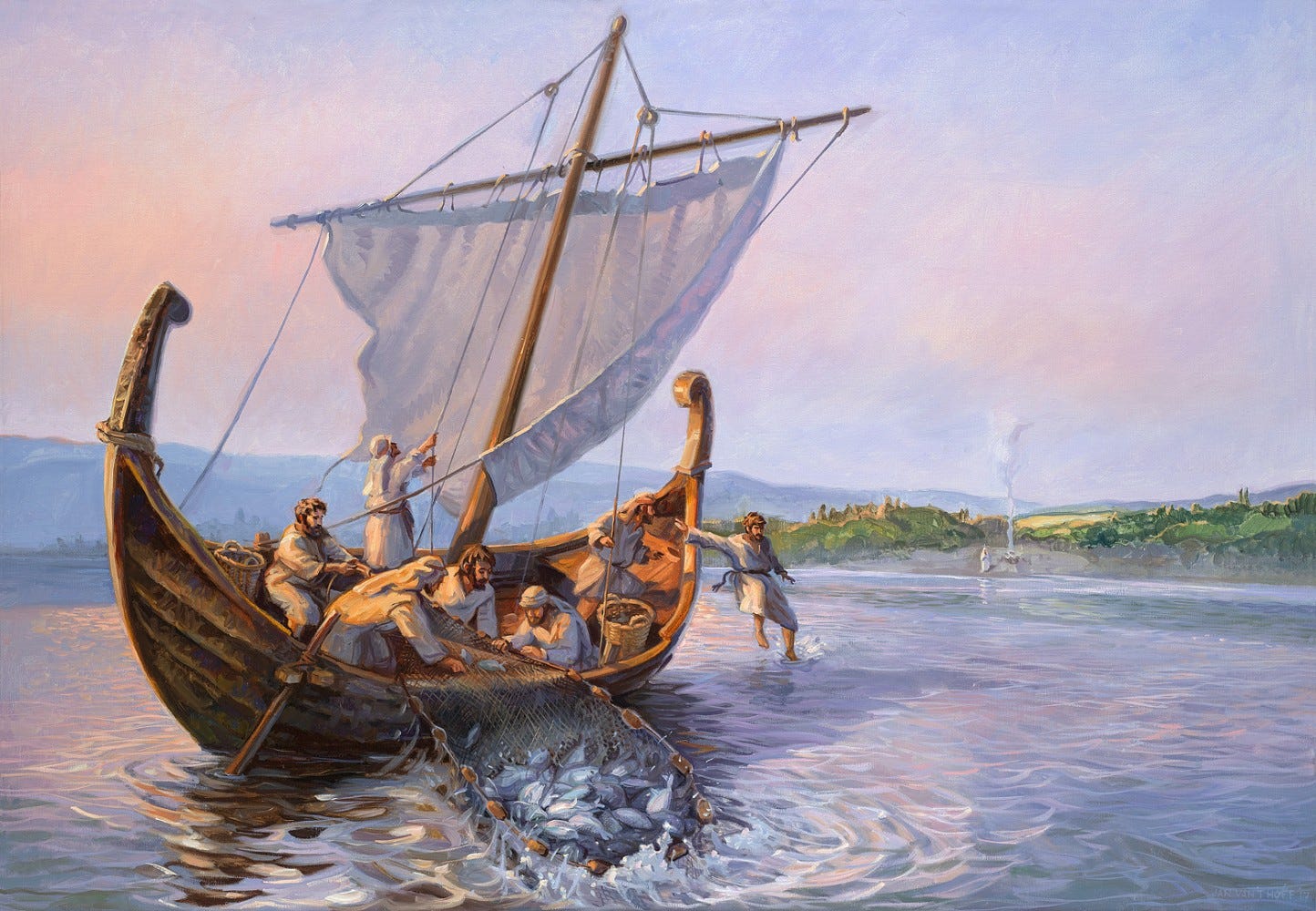
When they got out on land, they saw a charcoal fire in place, with fish laid out on it, and bread. Jesus said to them, "Bring some of the fish that you have just caught." So Simon Peter went aboard and hauled the net ashore, full of large fish, 153 of them. And although there were so many, the net was not torn. Jesus said to them, "Come and have breakfast." Now none of the disciples dared ask him, "Who are you?" They knew it was the Lord. Jesus came and took the bread and gave it to them, and so with the fish. This was now the third time that Jesus was revealed to the disciples after he was raised from the dead.
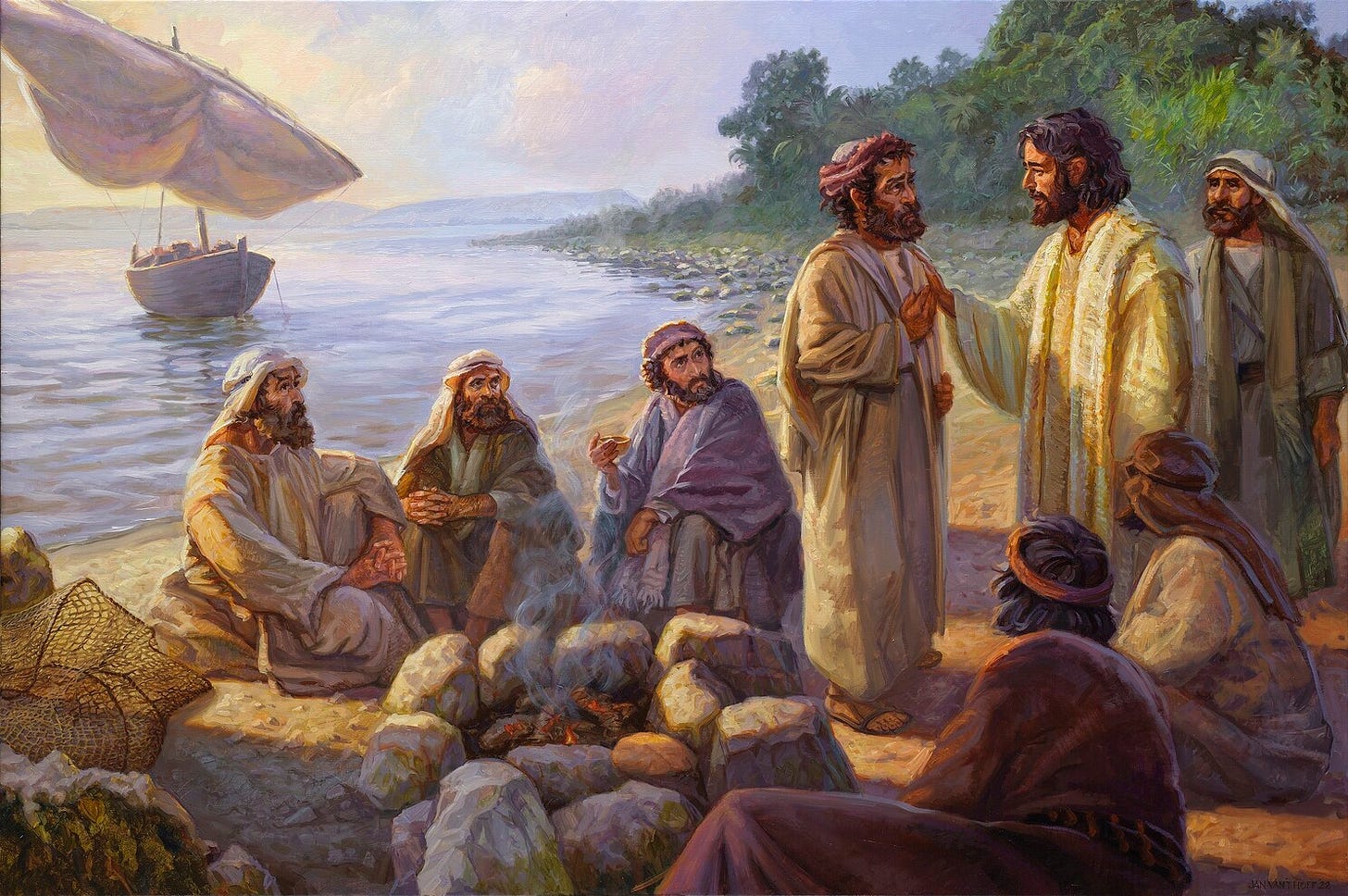
When they had finished breakfast, Jesus said to Simon Peter, "Simon, son of John, do you love me more than these?" He said to him, "Yes, Lord; you know that I love you." He said to him, "Feed my lambs." He said to him a second time, "Simon, son of John, do you love me?" He said to him, "Yes, Lord; you know that I love you." He said to him, "Tend my sheep." He said to him the third time, "Simon, son of John, do you love me?" Peter was grieved because he said to him the third time, "Do you love me?" and he said to him, "Lord, you know everything; you know that I love you." Jesus said to him, "Feed my sheep. Truly, truly, I say to you, when you were young, you used to dress yourself and walk wherever you wanted, but when you are old, you will stretch out your hands, and another will dress you and carry you where you do not want to go." (This he said to show by what kind of death he was to glorify God.) And after saying this he said to him, "Follow me."
Peter turned and saw the disciple whom Jesus loved following them, the one who also had leaned back against him during the supper and had said, "Lord, who is it that is going to betray you?" When Peter saw him, he said to Jesus, "Lord, what about this man?" Jesus said to him, "If it is my will that he remain until I come, what is that to you? You follow me!" So the saying spread abroad among the brothers that this disciple was not to die; yet Jesus did not say to him that he was not to die, but, "If it is my will that he remain until I come, what is that to you?"[53]
Now the eleven disciples went to Galilee, to the mountain to which Jesus had directed them. And when they saw him they worshipped him, but some doubted. And Jesus came and said to them, "All authority in heaven and on earth has been given to me. Go therefore and make disciples of all nations, baptizing them in the name of the Father and of the Son and of the Holy Spirit, teaching them to observe all that I have commanded you. And behold, I am with you always, to the end of the age."[54]
He presented himself alive to them after his suffering by many proofs, appearing to them during forty days and speaking about the kingdom of God. And while staying with them he ordered them not to depart from Jerusalem,[55] but to wait for the promise of the Father, which, he said, "you hear from me; for John baptized with water, but you will be baptized with the Holy Spirit not many days from now."[56]
Then he led them as far as Bethany.[57] So when they had come together, they asked him, "Lord, will you at this time restore the kingdom of Israel?" He said to them, "It is not for you to know times or seasons that the Father has fixed by his own authority. But you will receive power when the Holy Spirit has come upon you, and you will be my witnesses in Jerusalem and in all Judea and Samaria, and to the end of the earth." And when he had said these things, as they were looking on,[58] lifting up his hands he blessed them.[59] While he blessed them[60], he was lifted up[61], he parted from them and was carried up into heaven,[62] and a cloud took him out of their sight. And while they were gazing into heaven as he went, behold, two men stood by them in white robes, and said, "Men of Galilee, why do you stand looking into heaven? This Jesus, who was taken up from you into heaven, will come in the same way as you saw him go into heaven."[63]

And they worshipped him[64] and they returned to Jerusalem from the mount called Olivet, which is near Jerusalem, a Sabbath day's journey away[65], with great joy, and were continually in the temple blessing God.[66]
Recommended Resources:
Watch:
drcraigvideos, “Is There Meaning to Life?”, YouTube.com, Reasonable Faith, 16 Feb. 2018, 5:38, https://youtu.be/NKGnXgH_CzE
drcraigvideos, “Who Did Jesus Think He Was?”, YouTube.com, Reasonable Faith, 17 July 2018, 6:35, https://youtu.be/sSQDov6NNp0.
drcraigvideos, “How Can Jesus Be the Only Way?”, YouTube.com, Reasonable Faith, 19 Nov. 2019, 5:19, https://youtu.be/RRyq6RwzlEM.
The Passion of the Christ. Directed by Mel Gibson. Icon Productions, 2004. 2 hrs., 7 min. https://www.amazon.com/gp/video/detail/amzn1.dv.gti.cab95fa9-a2c7-4650-f31d-00e0cbdbeef6?ref_=imdbref_tt_wbr_shv__pvt_aiv&tag=imdbtag_tt_wbr_shv__pvt_aiv-20.
Risen. Directed by Kevin Reynolds. LD Entertainment, Affirm Films, and Columbia Pictures, 2016. 1 hr., 47 min. https://www.amazon.com/gp/video/detail/amzn1.dv.gti.46a9f796-a5f0-795e-19a4-9643d60cfe97?ref_=imdbref_tt_wbr_shv__pvt_aiv&tag=imdbtag_tt_wbr_shv__pvt_aiv-20.
The Jesus Film. Directed by John Krish and Peter Sykes. Inspirational Films, The Genesis Project, and The Jesus Film Project, 1979. 2 hrs., 8 min. https://www.jesusfilm.org/watch/jesus.html/english.html.
Listen:
Koukl, Greg. STR Weekly Podcast. Podcast. https://www.str.org/broadcast
Koukl, Greg and Amy Hall. #STRask. Podcast. https://www.str.org/strask
Petra, "Grave Robber," 1983, track 4 on Not Of This World, Star Song Records, 1983, compact disc. Listen here: UnknownPetraFan, "Petra - Grave Robber", YouTube.com, 19 Feb. 2008, 4:20, https://www.youtube.com/watch?v=3pQdCPlxP50&list=OLAK5uy_k6LWNWR9gIDUDgPZDAkwE_rYDuzPK5sY0&index=4.
Turek, Frank. I Don't Have Enough Faith to Be An Atheist. Podcast. https://crossexamined.org/podcasts/
Wallace, J. Warner. Cold-Case Christianity. Podcast. https://coldcasechristianity.com/category/podcasts/
Read:
Geisler, Norman L. A Popular Survey of the New Testament. 2007. Reprint, Grand Rapids, MI: InterVarsity Press, 2014.
⸻. In Defense of the Resurrection. 1993. 3rd ed. Reprint, Matthews, NC: Bastion Books, 2015.
Geisler, Norman L. and Frank Turek. I Don't Have Enough Faith to Be An Atheist. Wheaton, IL: Crossway, 2004.
Habermas, Gary. Evidence for the Historical Jesus: Is the Jesus of History the Christ of Faith. Cambridge, OH: Christian Publishing House, 2020.
Habermas, Gary. Risen Indeed: A Historical Investigation into the Resurrection of Jesus. 1976. Reprint, Bellingham, VA: Lexham Academic, 2021.
Habermas, Gary. On the Resurrection. Vol. 1, Evidences. Brentwood, TN: B&H Academic, 2024.
Habermas, Gary. On the Resurrection. Vol. 2, Refutations. Brentwood, TN: B&H Academic, 2024.
Kaiser Jr., Walter C., Peter H. Davids, F. F. Bruce, and Manfred T. Brauch. Hard Sayings of the Bible. Downers Grove, IL: InterVarsity Press, 1996.
Lewis, C. S. "Mere Christianity." In The Complete C. S. Lewis Signature Classics. 1st ed. New York: HarperSanFrancisco, 2002.
Powell, Doug. Resurrection iWitness. Nashville, TN: B&H Publishing Group, 2012.
Strobel, Lee. The Case for Easter: A Journalist Investigates the Evidence for the Resurrection. 1998. Reprint, Grand Rapids, MI: Zondervan, 2003.
Wallace, J. Warner. Cold-Case Christianity: A Homicide Detective Investigates the Claims of the Gospels. 2013. 2nd ed. Reprint, Colorado Springs, CO: David C Cook, 2023.
Wallace, J. Warner. Person of Interest. Grand Rapids, MI: Zondervan Reflective, 2021.
Download:
Stand to Reason App (Also Provides Link to Stand to Reason Quick-Reference App)
Stand to Reason Quick-Reference App (Direct Link to Stand to Reason Quick-Reference App)
Endnotes:
[1] See Norman L. Geisler, A Popular Survey of the New Testament (2007; repr., Grand Rapids, MI: Baker Books, 2014), 17-43, 45, 61, 77, 94-95. I disagree with Geisler’s dating of John’s Gospel due to the fact John uses a great deal of present-tense language. For example, John 5:2 says “Now there is in Jerusalem by the Sheep Gate a pool, in Aramaic called Bethesda, which has five roofed colonnades.” In the year A.D. 70, Jerusalem was destroyed by the Roman general Titus, including the Sheep Gate. Therefore, as Don Stewart observes, John “could not have made this statement after A.D. 70 – there was no sheep gate. […] This could very well be an indication that John wrote his gospel before the city of Jerusalem was destroyed.” See Don Stewart, “When Were the Four Gospels Written?”, BLB.org, Blue Letter Bible, 18 Jul. 2018, https://www.blueletterbible.org/Comm/stewart_don/faq/historical-accuracy-of-the-bible/question10-when-were-the-gospels-written.cfm?a=1002002.
[2] Geisler, 44-45; Matthew 9:9-13, 10:1-4.
[3] Geisler, 60-61; Mark 14:43-52 (esp. 51-52); Acts 15:36-41; Col. 4:10; 2 Tim. 4:11; 1 Peter 5:13.
[4] Geisler, 76-77; Col. 4:10-14; 2 Tim. 4:11; Philem. 23-24.
[5] Geisler, 93-94; Matthew 4:21-22, 10:1-4, 17:1-13; John 1:14, 13:21-30, 20:1-10, 30-31, 21:1-25.
[6] Geisler, 109-110; Luke 1:1-4, 22:39-24:53; Acts 1:1-11, 28:11-31; 2 Tim. 4:16-17; See also “What happened on Paul’s fourth missionary journey?”, GotQuestions.org, Got Questions Ministries, accessed Jan. 6, 2024, https://www.gotquestions.org/Paul-fourth-missionary-journey.html.
[7] John 1:35-51.
[8] The Sabbath is on Saturday. Sunday is the first day of the week.
[9] Mark 16:1.
[10] Matthew 28:1.
[11] Mark 16:1; John states it was still dark, and Mark says “when the sun had risen”. There are three options to consider: either A) The order presented in this synthesis is incorrect and Mary Magdalene went first and found the tomb empty, with the other women coming later; B) they are all simply relaying the fact it was very early when the news came out about the Resurrection; or C) John “zooms in” on Mary Magdalene specifically, not mentioning the other women, (much as Matthew and Mark will only mention one angel later, (the one that spoke), instead of mentioning both angels as Luke and John do). It is likely the women left at dark, toward the dawn, and Mark is referring to the sun being risen whenever the news came out. I chose to go with option B, though option A has produced other timelines which are perfectly reasonable as well, one of which is given in Dr. Norman Geisler’s Baker Encyclopedia of Christian Apologetics, (see Norman L. Geisler, “Resurrection, Objections to,” in Baker Encyclopedia of Christian Apologetics (Grand Rapids, Michigan: Baker Books, 1999). Option C seems the least likely out of the three, however it is not out of the question, as the Gospel authors do “zoom in” on certain accounts while the others seem to summarize the overall event, (such as Jesus healing the centurion’s servant in Matthew 8:5-13 and Luke 7:1-10). For further reading, consider Walter C. Kaiser, Jr, Peter H. Davids, F. F. Bruce, and Manfred T. Brauch’s Hard Sayings of the Bible (Downers Grove, IL: InterVarsity Press, 1996), especially the entry on John 20:1-8 titled “What Happened at the Resurrection?”
[12] Luke 24:1, 10; This sentence is a combination of Luke 24 verses 1 and 10 in order to identify Joanna as a member of the original group of women who went with Mary Magdalene, Mary the mother of James, Salome, and possibly others.
[13] Mark 16:3; The women are probably referring to the guards, (trained soldiers), who were not allowed to open the tomb, preventing anyone from entering it, (see Matthew 27:62-66). As an interesting note, if the body of Jesus was so important the Jewish leaders wanted it guarded, then it is likely each day and during the night the Jews would either go themselves or send someone else to check on the tomb to ensure things were going as planned until after three days.
[14] Matthew 28:2-4.
[15] Mark 16:4; The guards were Roman soldiers, and we know this because the Jewish leadership went to Pilate and requested a guard at the tomb, (see Matthew 27:62-66). Also, they went to the chief priests after being terrified, knowing if they went back to their commanders they would be executed per the penalty of Roman military codes, (see Matthew 28:11-15). The women looked up from either A) mourning and staring blankly at the path, B) the earthquake knocking them down, or C) a combination of both.
[16] Mark 16:4.
[17] Luke 24:4.
[18] Mark 16:5; This sentence is a reconstruction of Mark 16:5, which says in full: “And entering the tomb, they saw a young man sitting on the right side, dressed in a white robe, and they were alarmed,” thus communicating the same thing as Luke 24:4. Mark just focuses on the angel who sat down. Apparently, the angels would stand and sit in different places in the tomb throughout the morning, moving around in the tomb. This is a very tiny detail which provides more reliability for the accounts, as these beings were not simply stoic and standing the whole time as one might would expect an ultra-pious mind to conceive of heavenly beings. No, they were moving around in the tomb. It is very strikingly ordinary, which is very strange considering the supernatural nature of what has just happened with the Resurrection of Jesus Christ. If this were made up, it would be much more clean, polished, and “copy-and-paste,” so to speak, (or as Eric Metaxas puts it, there would probably be less “quirks” in the text if this was made up out of thin air, (see Eric Metaxas, Is Atheism Dead? (Washington, D.C.: Salem Books, 2021), 183-188).).
[19] Luke 24:5.
[20] Mark 16:6.
[21] Matthew 28:5.
[22] Luke 24:5.
[23] Matthew 28:6, (cf. Luke 24:6).
[24] Luke 24:6-7.
[25] Matthew 28:6, (cf. Mark 16:6).
[26] Matthew 28:7, (cf. Mark 16:7).
[27] Mark 16:7, (cf. Matthew 28:7); Peter was probably forlorn especially for his denial, (see Matthew 26:69-75, Mark 14:66-72, Luke 22:54-62, and John 18:15-18, 25-27).
[28] Matthew 28:7, (cf. Mark 16:7).
[29] Mark 16:7, (cf. Matthew 28:7).
[30] Matthew 28:7, (cf. Mark 16:7).
[31] Luke 24:8.
[32] Mark 16:8; Here is where the other women are excited and in disbelief, probably trying to figure out if the disciples would believe them and how to tell them. We see Mary does not know what to think, and still does not think Jesus is alive since she hasn’t seen Him. For Mary, there are two possibilities: either A) she ran off as soon as she saw the stone was rolled away, not going in and so she didn’t see the angels when the other women saw them, or B) she saw the angels, but she was so frightened and upset she didn’t register what was actually happening yet, possibly believing the angels, (who she may or may not have registered were actually angels), moved the body. Based on how she handles Jesus’ speaking to her at first in John 20:14-15, option B is certainly plausible and more likely. She goes alone to Peter and John. In the meantime, while everyone is running around trying to figure out what to do, the guards of the tomb have a report of their own, (see Matthew 20:11-15).
[33] Matthew 20:11-15; Some critics may try to argue this is Matthew’s attempt to try and cover up a conspiracy of the disciples stealing the body. However, this criticism fails for multiple reasons: first, the sincerity of the disciples; second, the conversions of Saul and James; third, the testimony of the women; and fourth, the public appearances of Jesus to multitudes of people. First, the disciples all died defending the truth of the Resurrection of Jesus Christ, and not one of them ever recanted their testimony and said it was a lie. People die for things that aren’t true, but they don’t die for things they know are not true, (i.e., people don’t die for things they believe are actually lies). In addition, they would have had to maintain this alleged conspiracy for over forty years while separated for thousands of miles, keeping their stories straight while have no easy means of communication. Conspiracies cannot survive, as Christianity has survived, under such conditions. In addition, it is interesting to note how the disciples were admitted cowards until after they saw Jesus rise from the dead. Afterwards, they refused to back down from their bold, public, and very radical testimony. Such honesty and a complete, radical transformation in character can only be explained by the truth of the Resurrection of Jesus Christ being an event which actually happened! Second, Saul of Tarsus was a vehement persecutor of the church prior to seeing the risen and ascended Jesus on the road to Damascus. There is no possible way Saul would have converted to follow Jesus as the true Messiah unless Jesus really was the true Messiah, because the very reason Saul was travelling to Damascus was to arrest and have executed for blasphemy anyone who was a follower of the Way, i.e., Jesus as the true Messiah. Saul believed Jesus was a false Messiah, and fought Jesus’ followers every step of the way until he converted on the road to Damascus. If Thomas, a man who followed Jesus for three years as a faithful disciple, refused to believe Jesus rose from the dead until he touched him, how much more proof would Saul, a vehement enemy of Christ, need in order to convert? His adamant defense of the Resurrection cannot be explained as if Saul were in on some sort of conspiracy. Further, the Apostle James, who was Jesus’ half-brother, did not believe Jesus was the Messiah. Yet he, a non-believer, suddenly became a believer overnight. A radical shift such as this, combined with the cumulative evidence already available, is only explainable by the fact James, like Paul, too witnessed the resurrected Jesus Christ and put his trust in Him as his Lord and Savior, (his own older Brother, with whom he had grown up in Nazareth, the God Who was holding James in existence throughout his whole life, and who knew him before he was ever formed in Mary’s womb! Talk about a radical family revelation!). Third, the first appearances of Jesus and the discovery of the empty tomb were all reported by women. In the first century, this would not have passed legal muster and the testimony of the women would not have been admitted as evidence in any court of law. If the disciples were forming a conspiracy, they would have based the testimony on male “witnesses” to make it more believable, i.e., they would never have made it harder to convince people to join their movement by making up women discovering the empty tomb and Jesus appearing to them first. Of course, if the testimony of the women was actually and absolutely true, and the Resurrection actually happened, then it would not matter whether the women were the first witnesses or not, because the truth does not change based on the gender of the witnesses who witness an event actually happen. Fourth, conspiracies can only succeed if they are formulated in a corner away from the public eye. However, as the Apostle Paul said, “this has not been done in a corner.” (See Acts 26:26) Jesus’ post-Resurrection appearances took place in groups of diverse size, in diverse locations, and over a period of forty days, (about a month and a half). In other words, there were far too many alleged co-conspirators, in too many places, for too long of a period of time in order for any alleged conspiracy to form. Too many variables, too many factors to possibly go wrong. So now the question becomes, “Okay, well then how did Matthew get this information about the guards?” There are several options. First, the Apostle Paul could very well have used his connections to get the truth from members of the Sanhedrin, of which he was a part prior to his conversion. Second, Nicodemus, a member of the Sanhedrin and a man who respected Jesus, could have gotten this information from the Sanhedrin himself. Third, Joseph of Arimathea could have gotten this information as well, as he was also a member of the Sanhedrin who refused to condemn Jesus when Jesus was on trial before the Sanhedrin. Fourth, one or more of the guards, if they converted in light of the truth of the Resurrection and what they had seen, could have confessed to what they had done to Matthew as he was writing his Gospel. Of course, another option could be the resurrected Jesus told Matthew Himself! Also, because the guard was obviously missing when Mary, Peter, and John return to the tomb later, where else would the guard have gone? To their commanders? As was already stated above, they would have been executed, even though it was not their fault and they were innocent of wrongdoing. And this particular insight seems to be characteristic of the Jewish leadership in the first century. They maintained under-the-table relations with the Romans, they had put Jesus to death for no good reason, they killed Christians in the early church, and they were attempting to maintain their power. It seems perfectly reasonable and consistent with their character for them to try and cover up their mistake, as the people of Israel and the Romans would go into an uproar if they knew Jesus was alive. There are plenty of very reasonable explanations as to why Matthew is telling the truth. This is most certainly not a conspiracy or cover-up, and it is most certainly Matthew telling the truth of what happened after Jesus Christ rose from the dead.
[34] John 20:2-10; The beginning of this sentence is restructured from John 20:1-2 simply to identify Mary Magdalene clearly for the reader. It is not a significant change to the text in any way, shape, or form. You may be wondering, “Where are the angels?” Angels could disappear and reappear as they were told by God or deemed fit. Or maybe the angels were walking with Jesus. Jesus would have special encounters with the disciples soon, so perhaps He wanted them to see the physical evidence first. Or perhaps God only wanted the women to see them, as to reinforce the truth of their testimony. Women were not to be believed in Jewish culture at the time in courts of law. Therefore, if the women testified consistently about the angels, and the disciples relied on their testimony, this would further reinforce they were not making this up. If they were, it would likely have reported angelic appearances to the men. Regardless, it does not matter where the angels are. The facts still remain: the tomb was empty and the only viable explanation is Jesus is alive today.
[35] John 20:11-13; One can imagine the angels thinking, “This is great news! Why does she not see the beautiful victory she is standing in?”
[36] John 20:13; At this point, Mary has been crying and does not yet believe in a Resurrection.
[37] John 20:14; Either she cannot recognize Jesus through supernatural prevention, (compare Luke 24:13-35), or simply she can’t see through the tears and morning light.
[38] John 20:15-18.
[39] Matthew 28:9; I insert this here because it is reasonable to believe that during this entire event at the tomb, the other women have finally calmed down enough to report what happened to the disciples. They were now going to tell the disciples the good news, possibly having run back and forth from the tomb in wonder and confusion.
[40] Matthew 28:9-10.
[41] Luke 24:9-12; It is likely Peter went twice, trying to figure out what had happened, hoping he too would see Jesus, which he did later on in a personal encounter, (see Luke 24:34 and 1 Corinthians 15:5). The next passage is the events on the road to Emmaus. The ending of Mark mentions this encounter as follows: “After these things he appeared in another form to two of them, as they were walking into the country. And they went back and told the rest, but they did not believe them.” (Mark 16:12-13) It was well known, then, the two had seen Jesus.
[42] Luke 24:13-35; Thomas, one of the eleven, probably left in disbelief, which is why he wasn’t in the room in the next bit.
[43] Luke 24:36.
[44] John 20:19; At this point, the Jewish leadership has probably reported to the Romans to hunt for the body. Knowing the Jews would try to find them and blame them for the missing body, the disciples and followers of Jesus hid from the hunters. While they searched for the body, it would be important to understand how extensive this search would be. The Romans needed the body to put down a possible political upheaval and the Jews needed the body to disprove Jesus as Messiah. Therefore, all of Jerusalem and the surrounding regions would be scoured. Every shallow grave, every tomb, every building. If the disciples had hid the body, it would begin to stink, so it would have been found fairly easily. If they had put spices on it to cover the stench, burial spices had a distinctive smell to them. So following one’s nose, it would have been easy to find the body. Of course, we still cannot explain Paul or James or many others without a Resurrection. Therefore, the disciples were hiding because they were innocent, Jesus really has risen from the dead!
[45] John 20:19, (compare Luke 24:36).
[46] Luke 24:37-40, (compare John 20:19
[47] John 20:20, (compare Luke 24:40).
[48] John 20:20.
[49] Luke 24:41-43.
[50] John 20:21-23.
[51] Luke 24:44-49; It is likely the Holy Spirit and the opening of their minds to the Scripture were one and the same event, not the special indwelling of Pentecost. However, it is also likely the Holy Spirit indwelled all in the room who believed, and Pentecost was a special manifestation of the already present Holy Spirit revealing and acting in a different and new way.
[52] John 20:24-29; At this point, we are already into the forty days Jesus is spending on Earth post-Resurrection, (which I do not put the statement of forty days until later in order to cover the gap between the encounters in Galilee and the Ascension). His disciples would have gone to Galilee, possibly spreading the news they had seen the risen Lord and gathering the five-hundred who would witness the risen Jesus which Paul mentions in 1 Corinthians 15.
[53] John 21:1-23.
[54] Matthew 28:16-20; Here, many people assume Jesus ascended after this, but this is just another place where Jesus is explaining to His followers their mission, and proving once again He is alive. He did not ascend until after they returned from Galilee.
[55] Acts 1:3-4a; After finishing their time in Galilee and returning as He directed.
[56] Acts 1:4b-5.
[57] Luke 24:50a.
[58] Acts 1:6-9a.
[59] Luke 24:50b.
[60] Luke 24:51a.
[61] Acts 1:9b.
[62] Luke 24:51b.
[63] Acts 1:9c-11.
[64] Luke 24:52a.
[65] Acts 1:12, (compare Luke 24:52-53).
[66] Luke 24:52b-53.



